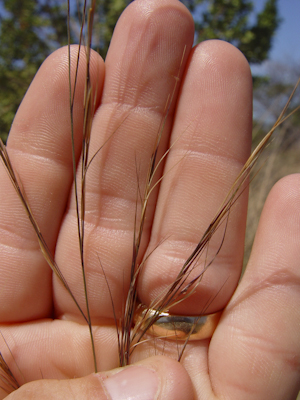Plants of South Florida · Plants by Conservation Area · Plants by County · Plants by Habitat Quick Search · Advanced Search |
||
|
|
||
 |
Aristida floridana (Chapm.) Vasey Key West threeawn |
|
|
South Florida Status: Critically imperiled. One occurrence at Little Hamaca Park. Taxonomy: Monocotyledon; Poaceae. Habit: Perennial terrestrial herb. Distribution: Apparently native to South Florida. Native to Mexico. South Florida Distribution: Monroe County Keys. South Florida Habitats: Dry, disturbed sites. Protection Status: Not listed by any agency due to dispute as to origin (see Comments). Aids to Identification: Hitchcock & Chase (1950) has an illustration. References: Chapman, 1883; Hitchcock, 1924; Henrard, 1926; Small, 1933a; Hitchcock & Chase, 1950; Long & Lakela, 1976; Hall, 1978; Wunderlin, 1998. Synonyms: A. ternipes Cav., misapplied; Ortachne floridana (Chapm.) Nash; Streptachne floridana Chapm. Historical Context: Key West threeawn was collected first on the island of Key West in the mid 1800s by either John Loomis Blodgett (s.n., NY) or Alvan W. Chapman (s.n., NY). It was not seen again until George N. Avery observed it in 1965 on Ramrod Key on a disturbed roadside (Avery’s Notes, 29 July 1965). Avery returned to that station in 1978, but the site had been destroyed (Avery’s Notes, 17 August 1978). Avery also found Key West threeawn on Key West along a railroad embankment in 1966, a site that was almost completely destroyed by 1978 (Avery’s Notes, 7 August 1966, 30 August 1978). Bradley rediscovered Key West threeawn in 1998 along a disturbed roadside at Little Hamaca Park on Key West. Major Threats: Stochastic extinction (e.g., hurricanes); management error; exotic pest plant invasions. Comments: There has been some discussion as to whether or not Key West threeawn is really native (e.g., Austin, 1981). It has been found only in the lower Florida Keys in open, dry, disturbed soils. Although it was originally thought to be a South Florida endemic, it is now known to be native to the Yucatan peninsula in Mexico, where it is relatively abundant. This issue needs further study. At a minimum, Key West threeawn should be protected from extirpation until the issue can be resolved. Recommendations: • Map and monitor known stations on a regular basis. • Study nativity of Key West threeawn. If the species is native, implement additional recommendations. • Conduct conservation biology and conservation horticulture studies. • Consider establishing an ex situ collection of germplasm. • Consider augmenting population at Little Hamaca Park. • Consider introducing populations to other sites within its historical range. |
||



